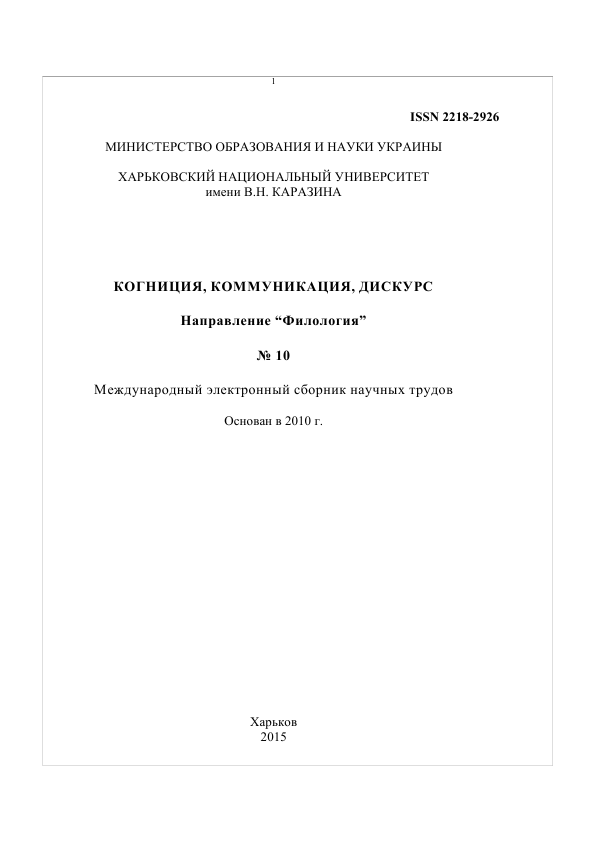Апроксимація як складова картини світу
Анотація
Стаття присвячена функціональній семантиці апроксиматорів у авторському дискурсі. Змодельовано концептосферу ‘апроксимація’ та семантичне поле ‘апрокcимaторів’. Доведено, що апроксиматори трансформують об’єктивну точну номінацію у суб’єктивну приблизну тільки при загальній пресупозиції комунікантів у структурі ‘непрофесійного’ дискурсу.
Завантаження
Посилання
Bellert, I. (1977). On Semantic and Distributional Properties of Sentence Adverbs. Linguistic Inquiry, 2, #. 2, 337–351.
Black, M. (1937). Vagueness: An Exercise in Logical Analysis. Philosophy of Science, 4, 427–455.
Hersch, H. A. (1976). Fuzzy Set Approach to Modifiers and Vagueness in Natural Language. Journal of Experimental Psychology, 105, # 3, 254–276.
Indurkhya, B. (1987). Approximate Transference: A Computational Theory of Metaphors and Analogies. Cognitive Science, 11, #4, 445–480.
Iranmanesh, Z. (2009). An Approach for Semantic Web Query Approximation Based on Domain Knowledge and User Preferences. In: Z. Iranmanesh, R. Piri, H. Adolhasani (eds.). Advances in Computer Science and User Preferences. Berlin: Springer Berlin Heidelberg. pp. 443–452.
Jaszczolt, K. (2002). Semantics and Pragmatics: Meaning in Language and Discourse. London: Pearson Education.
Lakoff, G. (1970). A Note on Vagueness and Ambiguity. Linguistic Inquiry, 1, 357–359.Lakoff, G. (1973). Hedges: A Study in Meaning Criteria and the Logic of Fuzzy Concepts. Journal of Philosophical Logic,2, 458–508.
Langacker, R.W. (1987). Foundations of Cognitive Grammar. Vol. 1: Theoretical Prerequisites. Stanford: Stanford University Press.
Martin, Th.B. (2007). A Typology of Ambiguity as it Relates to Natural Language Processing. Ann Arbor: Quest.
Mykhaylenko, V.V. (2014). Conceptual Analysis: Componential Analysis. Naukovy Visnyk Chernivetskogo univerytetu. – Chernivtsy University Messenger, 720: Germanic philology, 77–86.
Putnam, H. (1975). The Meaning of Meaning. In: K. Grunderson (d.). Language, Mind, and Knowledge. (Minnesota Studies in the Philosophy of Science, 7). Minneapois: University of Minnesota Press.
Rooij, R. van. (2011). Vagueness and Linguistics. Logic, Epistemology, and the Unity of Science, 19, 123–170.
Rowe, R. (2011). Approximation Semantics and Expressive Predicate Assignment for Object-Oriented Programming (Extended Abstract). Confrerence Absracts. London, 229–230.
Santos, D. (1998). The Relevance of Vagueness for Translation: Examples from English to Portuguese. TradTerem, 5, # 1, 71–98.
Thomason, R.H. (1973). A Semantic Theory of Adverbs, Linguistic Inquiry, 5, 195–220.
Wierzbicka, A. (2003). Cross-cultural Pragmatics: The Semantics of Human Interaction. Expanded 2-nd Edition. Berlin: Mouton de Gruyer.
Wierzbicka, A. (1985). Lexicography and Conceptual Analysis. Ann Arbor: Karoma.
Wierzbicka, A. (1986). Precision in Vagueness: The Semantics of English Approximators. Journal of Pragmatics, 10 (2), 597–613.
Wright, C. (2010).The Epistemic Conception of Vagueness. TSouthern Journal of Philosophy, 33, 1, 133–160.
Автори, які публікуються у цьому журналі, погоджуються з наступними умовами:
Автори залишають за собою право на авторство своєї роботи та передають журналу право першої публікації цієї роботи на умовах ліцензії Creative Commons Attribution License (CC BY), яка дозволяє іншим особам вільно розповсюджувати опубліковану роботу з обов'язковим посиланням на авторів оригінальної роботи та першу публікацію роботи у цьому журналі.
Автори мають право укладати самостійні додаткові угоди щодо неексклюзивного розповсюдження роботи у тому вигляді, в якому вона була опублікована цим журналом (наприклад, розміщувати роботу в електронному сховищі установи або публікувати у складі монографії), за умови збереження посилання на першу публікацію роботи у цьому журналі.
Політика журналу дозволяє і заохочує розміщення авторами в мережі Інтернет (наприклад, у сховищах установ або на особистих веб-сайтах) рукопису роботи, як до подання цього рукопису до редакції, так і під час його редакційного опрацювання, оскільки це сприяє виникненню продуктивної наукової дискусії та позитивно позначається на оперативності та динаміці цитування опублікованої роботи (див. The Effect of Open Access).




